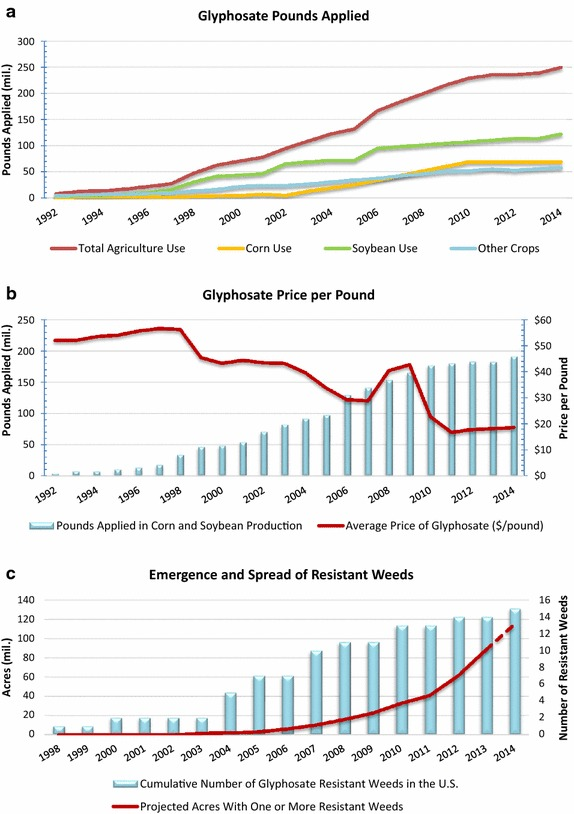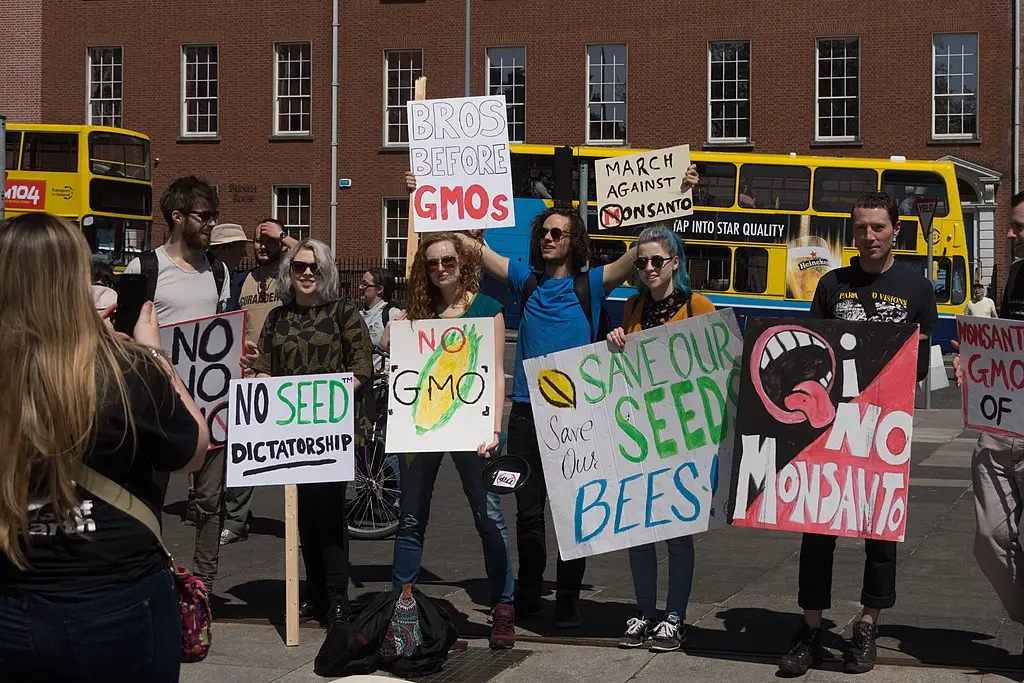Over the past six years, tens of thousands of plaintiffs have come forward with claims that glyphosate, the main ingredient in popular weed killer Roundup, led to serious and life-threatening cancer diagnoses. Bayer and Monsanto, the defendants in the Roundup litigation, continue to fight the charges in venues across the country, but have set aside more than $16 billion to cover lawsuit costs and paid out over $10 billion in settlements.
Wallace Miller is proud to represent plaintiffs in the Roundup weed killer lawsuits. If you or a loved one has suffered from a diagnosis of non-Hodgkin’s lymphoma as a result of exposure to glyphosate, contact our experienced Roundup lawyers for a free and confidential consultation today. Our office can be reached by phone at 312-261-6193 or via online questionnaire for an assessment in minutes.

Photograph by Pixabay.
Latest Monsanto Roundup Lawsuits Updates
January 2024 — On January 26, a jury in a Philadelphia Roundup trial awarded an unprecedented $2 billion in punitive damages and $250 million in compensatory damages to a plaintiff claiming that the corporation’s weedkiller products caused them to develop non-Hodgkin’s lymphoma. While compensatory damages are designed to make up for losses the plaintiff suffered as a result of their injury, punitive damages are intended to punish the defendants and deter others from following their example.
This verdict is one of several recent trial victories for plaintiffs regarding Monsanto’s Roundup weedkiller. However, defendants Monsanto and Bayer also prevailed in several earlier trials and the companies have said they plan to appeal.
Wallace Miller attorneys, including partner Timothy E. Jackson, are actively involved in the Roundup litigation and Wallace Miller is continuing to pursue cases.
December 2023 — In the fifth consecutive plaintiff victory, defendant Bayer was ordered on December 5 to pay more than $3 million by a jury in the Philadelphia Court of Common Pleas. After a three-week trial, the jury deliberated for two days before ruling 10-2 in favor of the plaintiff, who claimed that she developed non-Hodgkin’s lymphoma from Roundup exposure.
She was awarded $462,500 in compensatory damages (which compensate plaintiffs for their losses and can include medical bills, lost wages, and emotional distress) and $3 million in punitive damages (designed to punish defendants whose behavior is deemed especially harmful).
This verdict joins several other plaintiff victories in recent months with larger awards, including $1.56 billion awarded to three plaintiffs in November. Bayer has said that they intend to appeal. More than 150,000 claims have been made across the U.S., with over 50,000 still pending.
September 2023 — Nine consecutive trial verdicts have been decided in favor of defendants Bayer and Monsanto. Thousands of Roundup cases are still pending across the U.S.
June 2022 — The California-based 9th U.S. Circuit Court of Appeals orders the EPA to reexamine its 2020 report on the safety of Roundup.
February 2022 — Bayer has set aside more than $16 billion to cover the costs of Roundup cancer lawsuits.
August 2018 — The first of the cases brought against Monsanto for Roundup non-Hodgkin’s lymphoma claims are won by plaintiffs.
2018 — German-based chemical and pharmaceutical company Bayer buys Monsanto for more than $60 billion.
December 2017 — The U.S. Environmental Protection Agency (EPA) releases a report stating that glyphosate is “not likely” to cause cancer in humans, directly contradicting the 2015 report by the International Agency for Research on Cancer (IARC).
July 2017 — The state of California adds glyphosate to the list of chemicals “known to the state to cause cancer.”
January 2017 — The Roundup cancer cases are consolidated in a multidistrict litigation (MDL) in the U.S. District Court of the Northern District of California.
2015 — The IARC releases a monograph on glyphosate concluding that it is “probably carcinogenic to humans.”
2000 — Monsanto’s patent on glyphosate expires, allowing other companies to add the chemical to their products.
1996 — Monsanto begins selling “Roundup Ready” seeds, which are resistant to the effects of the Roundup weedkiller, allowing fields to be sprayed with the herbicide without harming the crops.
1974 — Roundup is approved for consumer use by the U.S. Food and Drug Administration (FDA) and Monsanto begins selling the product.
1950 — Swiss chemist Dr. Henri Martin discovers the chemical compound glyphosate.
1901 — Monsanto is founded as a chemical company in St. Louis.
1863 — Bayer is founded as a synthetic dye company in Barmen, Germany.
This content was reviewed by Timothy E. Jackson.
What is Roundup?
Roundup is a common herbicide, or weed killer, used in commercial and residential applications. It is by far the most widely used herbicide in the U.S. Every year, more than 200 million pounds of Roundup are sprayed on crops across the country.
Glyphosate, the active ingredient in Roundup, kills most plants it comes into contact with rather than targeting certain weeds. In 1996, Monsanto released the first “Roundup Ready” crops, which were designed specifically to resist the herbicide. This meant that farmers who used Monsanto seeds could spray their entire fields with Roundup and kill everything except for the resistant crops.
As the use of these genetically modified crops has grown, the amount of the Roundup herbicide sprayed—and therefore the amount absorbed by plants and eventually humans and livestock—has increased as well. In the 40 years after the product’s launch, the use of Roundup has increased more than a hundredfold.
In 2022, a study from the Centers for Disease Control and Prevention (CDC) found that 80% of U.S. individuals in the study had detectable levels of Roundup in their urine. And while the health risks of glyphosate continue to be investigated, it is possible that the combination of ingredients in Roundup make the weed killer even more toxic.
What is glyphosate?
The main ingredient in Roundup, glyphosate is a non-selective herbicide, or weed killer. Discovered by Swiss chemist Dr. Henri Martin in 1950, no pharmaceutical applications for the chemical were identified until Monsanto chemist Dr. John Franz discovered its herbicidal use in 1970.
Roundup is not the only weed killer that contains glyphosate. Since Monsanto’s patent on the chemical expired in 2000, more than 750 herbicides that contain the chemical have been sold in the U.S. These include Ranger Pro Herbicide (also manufactured by Monsanto), Compare-N-Save Concentrate Grass and Weed Killer, and Ortho GroundClear.
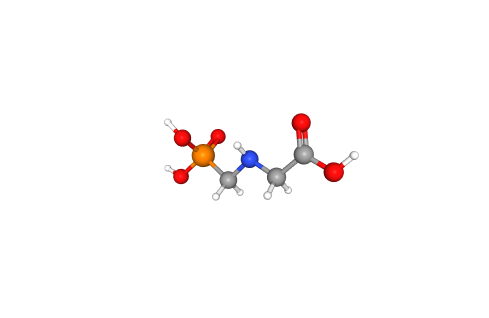
The molecular structure of glyphosate, the active ingredient in Roundup. Photograph courtesy of National Center for Biotechnology Information.
How does glyphosate work?
Glyphosate operates by blocking a particular enzyme (enolpyruvyl-shikimate-phosphate synthase) that regulates plant growth. After Roundup is sprayed, the leaves of the plant absorb the ingredient, which then travels to other parts of the plant, including the roots. This prevents further growth and eventually kills the plant.
For decades, glyphosate was believed to be a safe alternative to more toxic pesticides due to the fact that it works on an enzyme that is not present in humans. However, the enzyme is present in bacteria that help to regulate the human body, and studies have increasingly shown the chemical’s impact on animal life. In 2015 the International Agency for Research on Cancer, part of the World Health Organization (WHO), classified glyphosate as a , or “probably carcinogenic to humans.” Other substances in this group include inorganic lead compounds and the insecticide DDT.
Who is most at-risk for glyphosate exposure?
Certain groups are more likely to come in contact with glyphosate because of frequent and prolonged Roundup use. The groups at the highest risk of exposure include:
- Landscapers
- Farmers
- Groundskeepers
- Workers in pesticide and herbicide application
- Professional gardeners
- Agricultural workers
However, individuals who use Roundup for residential use can also be at risk of glyphosate exposure, depending on the duration and intensity of use.
What are the side effects of glyphosate exposure?
A number of scientific studies have indicated that individuals with heavy exposure to Roundup, such as landscapers and farmers, have an increased risk of developing non-Hodgkin’s lymphoma. According to a study from the University of Washington, people who frequently use Roundup have a 41% higher risk of developing these cancers over their lifetimes than people who use it rarely or never.
The weed killer’s acute toxicity—or that caused by exposure to Roundup over a short period of time—is relatively low. However, studies on animals have shown that the effects of long-term exposure are much more dangerous. According to an article published in the journal Entropy, “the negative impact on the body is insidious and manifests slowly over time.”
In the short term, topical Roundup exposure may cause eye or skin irritation. If inhaled, it can cause irritation in the nose and throat, and if swallowed its effects include burns, nausea, vomiting, diarrhea, low blood pressure, and convulsions, as well as damage to liver and kidneys.
In addition to its documented correlation with non-Hodgkin’s lymphoma, Roundup has been shown to alter the human gut microbiome, which increases susceptibility to a number of other chronic health problems including depression, irritable bowel syndrome (IBS), Alzheimer’s, and Parkinson’s. It has also been shown to cause reproductive damage in animals via factors including changes in the blood levels of estrogen and testosterone and damage to reproductive tissues.
Although research continues in these areas, several scientific organizations including the IARC have established a link between Roundup and non-Hodgkin’s lymphoma. Since 2016, more than 100,000 plaintiffs have come forward with allegations that exposure to Monsanto’s Roundup led to their cancer.
If you or a loved one has used Roundup and been diagnosed with non-Hodgkin’s lymphoma, get in touch with the lawyers at Wallace Miller to evaluate your case. Call our office at 312-261-6193 or fill out our online questionnaire to receive a confidential and free consultation in minutes.
What is non-Hodgkin’s lymphoma?
Non-Hodgkin’s lymphoma is a form of cancer that starts in the white bloods cells, or lymphocytes, an important part of the body’s immune system. Lymphocytes are divided into two groups: B lymphocytes, which make antibodies that protect the body from viruses and bacteria; and T lymphocytes, which boost or slow down the activities of other cells in the immune system.
Lymphoma can form in the lymph tissue in any area of the body, including the spleen, digestive tract, lymph nodes, bone marrow, adenoids, and tonsils. Non-Hodgkin’s lymphomas are the sixth-most common group of cancers in the U.S. and kill about 20,000 people in the country each year.
Common symptoms of non-Hodgkin’s lymphoma
The symptoms of non-Hodgkin’s lymphoma depend on the location and type of lymphoma that develops. Common symptoms may include:
- Swollen abdomen
- Chills
- Frequent or severe infections
- Unexplained weight loss
- Shortness of breath
- Cough
- Fatigue
- Enlarged lymph nodes
- Easy bleeding or bruising
- Chest pressure or pain
- Feeling full after eating a small amount
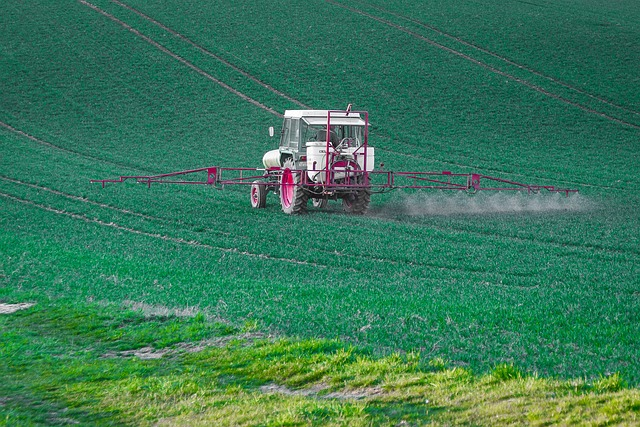
Photograph by Pixabay.
The history of Roundup
Worldwide, Roundup is the most popular weed killer ever sold. It was approved for consumer use by the FDA in the 1970s, and for decades had the reputation of being safer than herbicides like DDC, atrazine, or Paraquat.
In 1996, Monsanto started selling crops that were genetically modified so that they could tolerate Roundup, developed from genes found outside a Monsanto glyphosate factory. Growing plants from these “Roundup Ready” seeds allows farmers to spray their fields and kill weeds but leave crops intact.
Monsanto rapidly became the biggest seed company worldwide, with its sales increasing tenfold. Over the next several decades, organizations including March Against Monsanto and U.S. Right to Know organized protests against the use of genetically modified organisms, leading to the passage of a GMO labeling bill in 2016.
As a result of the increased use of Roundup Ready seeds and the subsequent increase in glyphosate use, the incidence of weeds that are tolerant and resistant to herbicides has grown significantly in the U.S. This has led farmers to increase the amount of Roundup applied, which has led to higher levels of glyphosate in crops and water and increased potential exposure to humans and animals.
The 2015 assessment from the International Agency for Research on Cancer
In 2015, the International Agency for Research on Cancer (IARC) reviewed approximately 1000 scientific studies and classified glyphosate as a Group 2A carcinogen, or “probably carcinogenic to humans.” This category also includes substances like the insecticide DDT and inorganic lead compounds. The IARC concluded that “the data from all of the studies combined show a statistically significant association between non-Hodgkin lymphoma and exposure to glyphosate.” This evaluation was based on publicly available studies that had undergone standard peer-review processes.
Immediately after the IARC study was released, Monsanto began a campaign to silence the organization. Members of Congress wrote to the National Institutes for Health questioning IARC funding—efforts that recently released emails have revealed were coordinated and in some cases ghostwritten by a Monsanto consulting firm. A number of pesticide lobbying groups approached the participating states of the IARC’s governing council to challenge the organization’s quality of work. And under oath, Monsanto executives later admitted to building a confidential program aimed at countering criticisms called “Let Nothing Go.”
Other studies on the effects of Roundup exposure
After the results of the IARC investigation were published, several other organizations launched their own reports on the effects of glyphosate. These included reports from the European Food Safety Authority and the U.S. Environmental Protection Agency (EPA), both of which found that glyphosate does not pose an “unreasonable” risk to humans.
The primary difference between the studies conducted by the EPA and other organizations and the report by the IARC is the evidence considered for each review. By official policy, the IARC reviews only data and studies that are in the public domain and have been independently peer-reviewed. However, the EPA and other organizations consider studies that are not publicly available due to the fact that they have been funded and submitted to the agencies by Monsanto or industry lobbying groups.
Monsanto has received increased scrutiny in recent years over allegations that they have ghost-written scientific papers and passed them along to scientists to approve and publish. According to reporting by the New York Times, a scientist involved in Monsanto research wrote in a 2015 email, “I can’t be part of deceptive authorship on a presentation of publication.” In reference to the presentation of authorship minimizing Monsanto’s role, he wrote, “We call that ghost writing and it is unethical.”
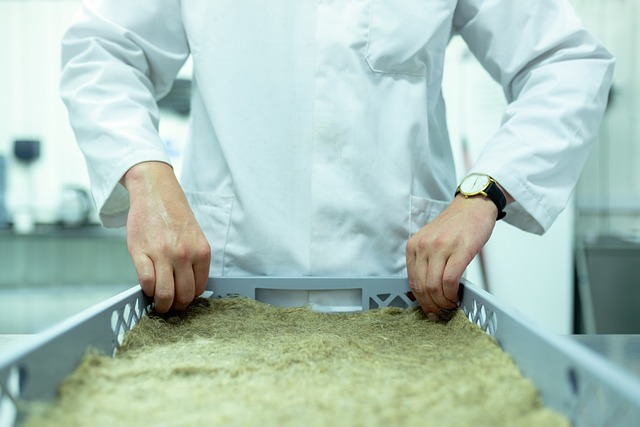
Photograph by Pixabay.
Monsanto has submitted more than 800 studies to the EPA and European regulatory agencies claiming that glyphosate is safe. As these papers are not available to the general public, the IARC did not consider them in their review. In addition, the EPA focused their evaluation on the use of glyphosate in food crops, while the IARC took into account the higher levels of exposure for those in at-risk professions.
Further research has supported the findings of the IARC. A 2019 study from the University of Washington found that Roundup use increased the risk of non-Hodgkin’s lymphoma by 41 percent. And in 2022, Judge Michelle Friedland ruled that the EPA’s finding that glyphosate posed no risk to human health “was not supported by substantial evidence.” Her report stated that the EPA “did not adequately consider whether glyphosate causes cancer and shirked its duties under the Endangered Species Act” and ordered the agency to reevaluate the evidence.
What are the “Monsanto Papers”?
As part of the process of plaintiffs filing Roundup lawsuits, Monsanto was required by the courts to release millions of pages of internal records. Revelations in these emails include:
- A close relationship between Monsanto and a senior EPA regulator who promised to shut down further studies, including one by the Centers for Disease Control and Prevention (CDC);
- Monsanto ghostwriting a pro-Roundup op-ed for Forbes that was published by scientist Henry Miller (the information provided by the emails led to Forbes dropping Miller and pulling his articles—many of which promoted pesticides and attacked the organic industry—from their website);
- Monsanto officials avoiding pursuing studies that might show negative results, preventing contractors from repeating studies that could reveal dangerous effects of glyphosate, and suppressing the findings of scientists who called attention to the chemical’s risks; and
- Additional accusations of ghostwriting scientific papers, including a pivotal 2000 study on glyphosate safety that asserted the chemical had no human health concerns.
In 2018, an article published in the International Journal of Risk & Safety in Medicine found that Monsanto routinely interfered in the scientific process and suppressed independent questioning of glyphosate safety. The article stated, “The use of third-party academics in the corporate defense of glyphosate reveals that this practice extends beyond the corruption of medicine and persists in spite of efforts to enforce transparency in industry manipulation.”
The Roundup multidistrict litigation (MDL)
Individual Roundup lawsuits were consolidated in 2017 into a multidistrict litigation (MDL) in the U.S. District Court of the Northern District of California. MDLs are often utilized when a large number of lawsuits are filed against the same defendant or group of defendants. Instead of investigating the circumstances of each case separately, the Roundup MDL will consolidate past and future Roundup cancer claims and allow plaintiffs, defendants, and courts to gather information on issues shared by all the cases at once.
Throughout this process, the case of each individual plaintiff remains separate. If the attorneys don’t reach a settlement that applies to all cases, the litigations may be sent back to their individual district courts to be tried.
Monsanto: A controversial company
Monsanto was founded in St. Louis in 1901 as a manufacturer of synthetic sweetener. The company rose to prominence as the developer and manufacturer of Agent Orange, a highly toxic defoliant used by the U.S. military in Vietnam, as well as PCBs (polychlorinated biphenyls), toxic industrial chemicals that have been shown to remain in the environment for long periods of time.
Monsanto has attracted a broad range of controversy over its years as one of the largest seed and herbicide companies in the world—not just due to its use of genetically modified organisms (GMOs) and manufacture of toxic chemicals, but also because of its aggressive litigation against individual farmers.
When farmers purchase Roundup Ready seeds, they are required to sign paperwork that prohibits them from replanting the seeds the following season. This creates a consistent market for Monsanto’s seeds, every season. As a result of violations of this contract, the company has repeatedly targeted individual farmers and small companies for the “misuse” of patented seeds. In total, they have filed more than 140 lawsuits against over 400 farmers and more than 50 small businesses. They have won all cases taken to trial in the U.S. and have made over $23 million from these targeted litigations—perhaps not surprisingly when considering the financial might of a multinational corporation against local farmers.
These lawsuits have had a strong negative impact on farmers, many of whom plant in genuine ignorance of the strict terms of the patent contract (or had seeds cross-pollinated with Monsanto stock by the wind) and are forced into bankruptcy by the lawsuits. The nonprofit Center for Food Safety condemned Monsanto’s Roundup lawsuit practices, writing, “Corporations did not create seeds […] a resource that is vital to survival and that historically has been in the public domain.”
In addition to the strict patent contracts, Monsanto also claims “royalties” on crops grown from Roundup Ready seeds, demanding 5% of profits on top of the cost of seeds. This fee is a considerable burden to farmers, especially as it has grown more difficult to purchase and grow non-Monsanto seeds. In the U.S. market, 93% of soybeans and 86% of corn is genetically modified. Monsanto’s “big three” crops—corn, soy, and cotton—cover more than half of U.S. farmland.
Proponents of Monsanto argue that these modified crops are essential to feed the world as the global population continues to expand. However, the record-breaking profits of these companies at the expense of farmers appear to have little to do with feeding the world. In addition to the burden placed on small businesses and local farmers and the environmental effects of herbicides like Roundup, a study from Purdue University has found “little to no evidence” that GMOs have actually increased corn production over the past 25 years.
Monsanto’s business practices made it one of the largest companies in the world. In 2018, the corporation was purchased by Bayer for more than $60 billion dollars. Shortly thereafter, it was integrated into Bayer’s crop division and ceased to exist as an independent entity.

The Bayer building in Diegem, Belgium, featuring the slogan, “Science for a better life.” Photograph by Trougnouf, CC BY 4.0, via Wikimedia Commons.
Bayer AG: Roundup’s new owners
Bayer AG is a German chemical and pharmaceutical company and a long-time rival of Monsanto. Founded in 1863, the company is famous as the first manufacturer of aspirin in 1899 and the first company to mass-produce heroin for use in pain and cough medicine in 1898.
During World War I, Bayer helped develop and manufacture explosives and chemical weapons, including chlorine gas. Twenty years later, during World War II, they became part of IG Farben, a German chemical conglomerate infamous for its use of slave labor and experiments on live human subjects in concentration camps. In at least one experiment conducted by IG Farben with direct involvement from Bayer officials, 150 prisoners were forced to participate in tests of a new drug. All 150 died as a result.
After the war, a number of company officials were convicted of crimes against humanity for slavery and mass murder. Chief Prosecutor of the Nuremberg War Crimes Trial Telford Taylor stated during the trials: “These companies, not the lunatic Nazi fanatics, are the main war criminals.” The strictest sentence to be sent down to Bayer executives was eight years, for those directly involved in running the IG Farben plant that used slave labor.
The Allies divided IG Farben into several new companies, one of which was Bayer AG. After release from prison, one of the convicted war criminals—who stated in his trial that “forced labor did not inflict any remarkable injury, pain, or suffering on the detainees”—was reinstated to Bayer’s managing board.

Photograph by Pixabay.
Bayer finalized the purchase of Monsanto in 2018 for $66 billion. Later that year, the first Monsanto Roundup lawsuit was decided in favor of the plaintiff. As a result, Bayer saw the value of Monsanto decline, and folded the company into their crop science division.
Although Bayer continues to assert the safety of Roundup, the company has committed to replacing glyphosate-based products on the market with other active ingredients beginning in 2023. However, this shift only applies to residential markets. In professional and agricultural markets, Roundup containing glyphosate will continue to be sold. As of 2020, 90 percent of glyphosate is applied to agricultural land globally, with the remaining 10 percent including industrial and residential applications.
Roundup cancer lawsuits: Frequently asked questions
Why is Roundup still being sold?
Despite the warnings of the IARC and cancer researchers around the world, Roundup and other herbicides containing glyphosate continue to be sold in the U.S. As of 2022, the EPA maintains that glyphosate has a low toxicity for humans, although they note that pets may be at risk if they come into contact with plants that have been recently sprayed. Bayer will no longer sell Roundup for residential use beginning in 2023, but it will remain available for use in commercial and professional settings.
Glyphosate has been or is in the process of being banned in a number of countries, including Brazil, Saudi Arabia, Belgium, Denmark, Portugal, Thailand, Vietnam, and most of Canada. Several European countries, including France, Austria, and Germany, have announced restrictions on its use.
What forms of cancer are eligible for the Roundup lawsuit?
Plaintiffs diagnosed with a variety of forms of non-Hodgkin’s lymphoma may be eligible to participate in a Roundup lawsuit. These include:
- B-cell lymphoma
- Small lymphocytic leukemia (SLL)
- Chronic lymphocytic leukemia (CLL)
- Lymphoblastic lymphoma
- Mantle cell lymphoma
- Burkitt lymphoma
- Hairy cell leukemia (HCL)
- Follicular lymphoma
- Types of lymphoblastic leukemia
- Types of T-cell lymphoblastic leukemia
Other forms of non-Hodgkin’s lymphoma may also be eligible to participate in the Roundup litigation. An experienced Roundup lawyer at Wallace Miller can help evaluate your case and determine whether you may be able to file a lawsuit against Bayer and Monsanto.

Photograph by Pixabay.
Am I eligible for the Roundup lawsuit?
You may be able to participate in a Roundup weed killer lawsuit if your case meets the following criteria:
- You used or were exposed to Roundup for at least one year before your cancer diagnosis. Common means of exposure include work as a landscaper, farmer, farmhand, picker, drainage expert, or another type of worker in a context where the pesticide was used. Roundup may also have been used for residential purposes.
- You have been diagnosed with non-Hodgkin’s lymphoma.
- Your cancer diagnosis took place after 1999.
Non-Hodgkin’s lymphoma is a serious disease that can lead to long-lasting health issues, expensive medical bills, and even death. If a loved one has passed away as a result of cancer that may be linked to Roundup exposure, you or a representative may be able to file a wrongful death lawsuit on their behalf.
Is there still time to file?
While some settlements have been reached in Roundup lawsuits, Wallace Miller is still actively taking cases for participation in the MDL. If you think you may have a case against the manufacturers of Roundup, get in touch with our law firm today.
Different states will often have different statutes of limitations, which affect how long after a cancer diagnosis you may be able to file a Roundup lawsuit. The best way to determine if your case is eligible is to contact our firm today at 312-261-6193 or via our online questionnaire for a confidential and free consultation.
How do I file a Roundup lawsuit?
The first step in filing a Roundup lawsuit is reaching out to our team of attorneys. We will discuss your case with you, including the history of your Roundup use, any injuries sustained as a result, and medical treatment you received for those injuries. From there, our Roundup lawyers will assess your situation and determine whether we think you have a case against Bayer and Monsanto.
How much will it cost to hire a Roundup lawyer?
Wallace Miller relies entirely on successful settlements to pay our operation fees, so there is no out-of-pocket cost for our clients. This means that you will not incur any kind of fee for your Roundup lawsuit unless we win your case.
What is the average settlement for a Roundup lawsuit?
In any litigation, there is no guarantee of a settlement or jury verdict in your favor. However, the bellwether trial process can help both the plaintiff and the defense counsel to evaluate the strengths and weaknesses of the case. During this process, both parties can test the legal theories and injuries involved in the case in front of a jury. From there, factors specific to the individual plaintiff’s case, such as medical history, related conditions, and the amount and type of product use, may influence the settlement offer amount.
Since this is a mass tort and not a class action, if a global settlement is eventually reached, the amount each plaintiff receives will depend on their situation. Global settlements—or settlements that apply to multiple plaintiffs—are often divided up into tiers. The plaintiffs in these tiers will receive different set amounts typically based on the type and severity of injury they suffered.
In litigations so far, Monsanto-Bayer has settled more than 100,000 Roundup lawsuits and paid out more than $10 billion in settlements. Our lawyers are committed to fighting for the best possible outcome for all plaintiffs involved. They will work with you throughout the process to keep you informed about your case and what is happening with the MDL, including the likelihood of a settlement and your potential award amount.
Wallace Miller: Fighting for your Roundup cancer lawsuit
The legal team at Wallace Miller is proud to represent plaintiffs in mass tort litigations across the U.S. Our law firm is focused on protecting the victims of negligence and fraud through consumer protection, product liability, employment, environmental and toxic harm, and personal injury litigation.
We know that there are many choices available to you when looking for a lawyer to represent you in cases like the Roundup lawsuit. What sets us apart from other firms is our commitment to our clients, our ability to handle complex high-stakes litigation, and our outstanding track record of success. We only take on cases that our firm has faith in—those that can make a difference in our clients’ lives.

Left to right: Nicholas P. Kelly, Edward A. Wallace, Molly Condon Wells, Mark R. Miller, Jessica Wieczorkiewicz, Timothy E. Jackson.
Questions about your potential Roundup exposure case? Call our office at 312-261-6193 or fill out our online questionnaire for a confidential and free consultation.


